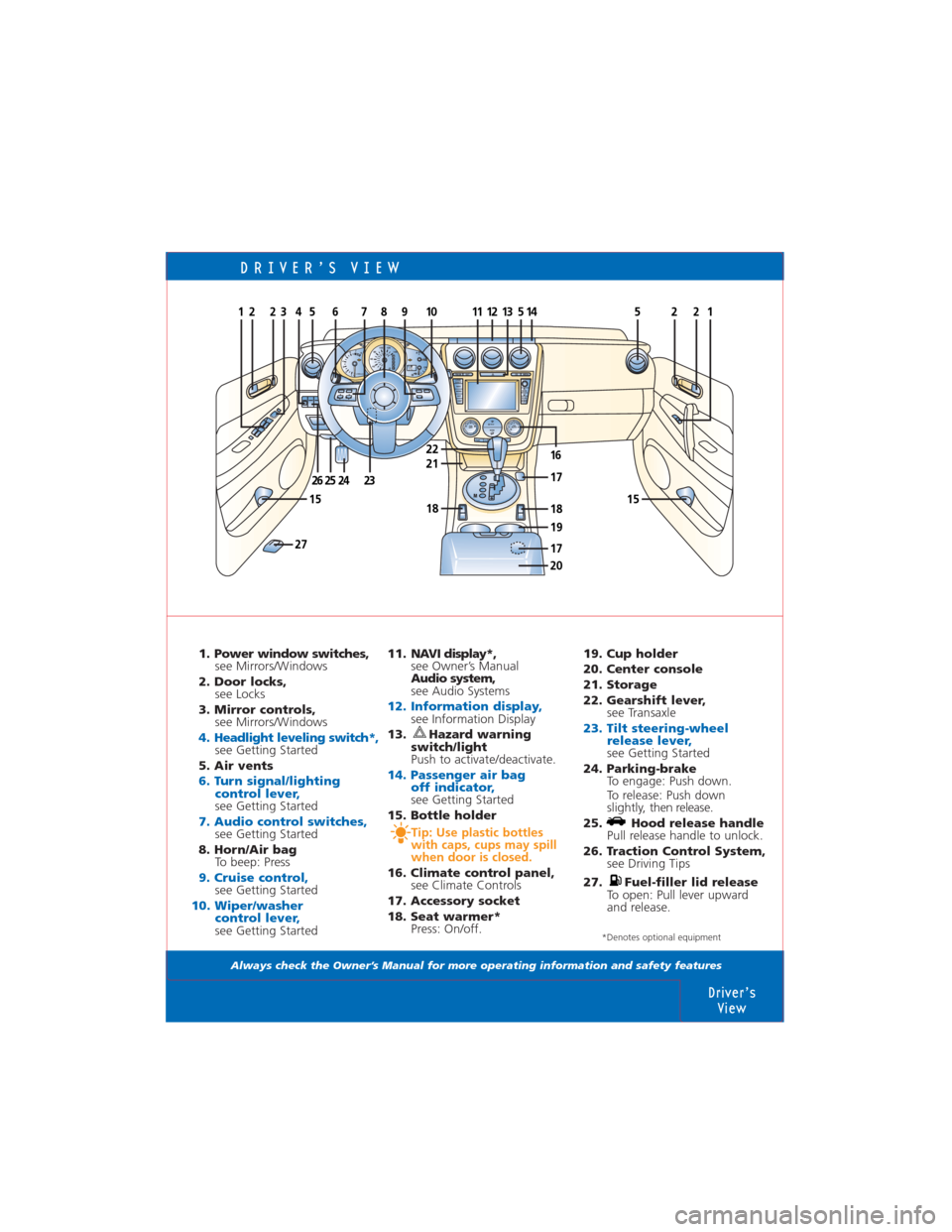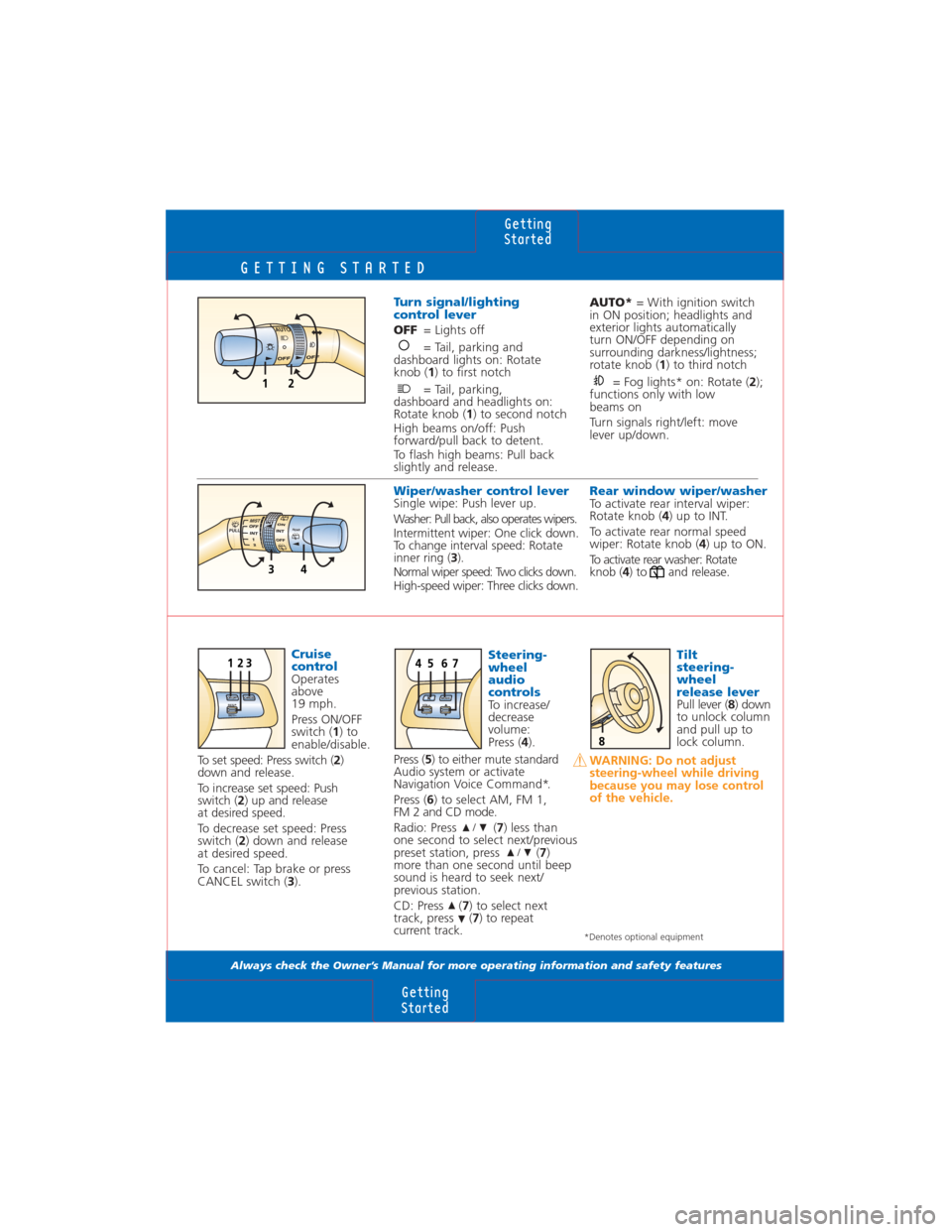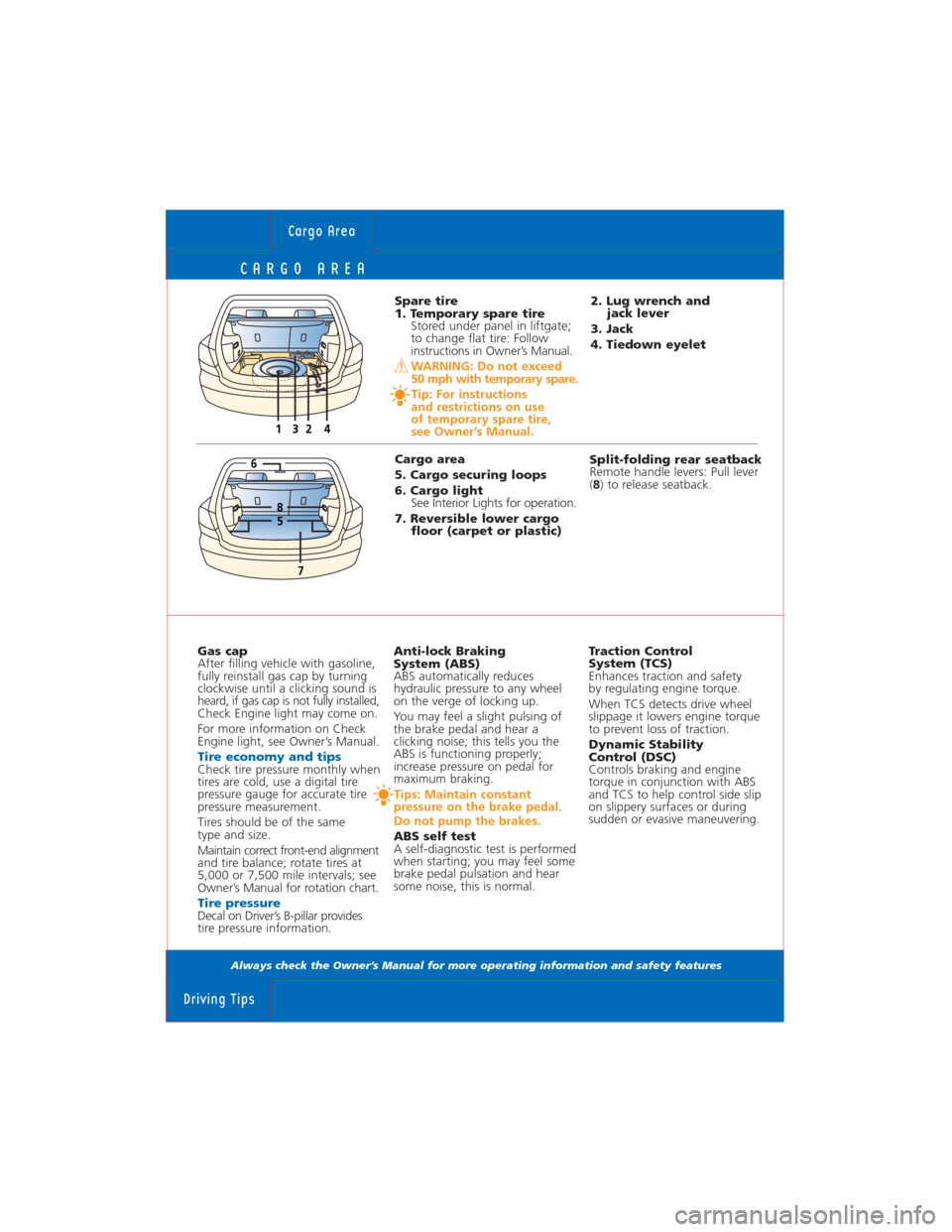wheel MAZDA MODEL CX-7 2008 Quick Tips (in English)
[x] Cancel search | Manufacturer: MAZDA, Model Year: 2008, Model line: MODEL CX-7, Model: MAZDA MODEL CX-7 2008Pages: 15, PDF Size: 1.76 MB
Page 2 of 15

DRIVER’S VIEW
Always check the Owner’s Manual for more operating information and safety features
1. Power window switches,
see Mirrors/Windows
2. Door locks,
see Locks
3. Mirror controls,
see Mirrors/Windows
4. Headlight leveling switch*, see Getting Started
5. Air vents
6. Turn signal/lighting
control lever,
see Getting Started
7. Audio control switches,see Getting Started
8. Horn/Air bag
To beep: Press
9. Cruise control, see Getting Started
10. Wiper/washer
control lever,
see Getting Started11. NAVI display*,
see Owner’s Manual
Audio system,
see Audio Systems
12. Information display,see Information Display
13. Hazard warning
switch/light
Push to activate/deactivate.
14. Passenger air bag
off indicator,
see Getting Started
15. Bottle holder
Tip: Use plastic bottles
with caps, cups may spill
when door is closed.
16. Climate control panel,
see Climate Controls
17. Accessory socket
18. Seat warmer*
Press: On/off.
Driver’s
View
TRIPA773.7
67498
H140
8 7
6
5
4
3
2
1
0220
40 60 80 100120140160180
200
20120 100
80
60
40
20
0C
Fx1000km/minE
P
R
N
D
M
122225
242526
3
1515
27
19
541
18
21
18
A/C AMBCHPUSHAUTOPUSHOFFFRONTMODE
51214
16
17
22
108796
23
FM/AM SAT CD MEDIAPUSHPOWER/VOL
SCAN
AUDIOSEEK
TRACK NAVI
MENU
RET
DISP LOAD
EJECT
1113
17
20
19. Cup holder
20. Center console
21. Storage
22. Gearshift lever,
see Transaxle
23. Tilt steering-wheel
release lever,
see Getting Started
24. Parking-brake
To engage: Push down.
To release: Push down
slightly, then release.
25. Hood release handle
Pull release handle to unlock.
26. Traction Control System,
see Driving Tips
27. Fuel-filler lid release
To open: Pull lever upward
and release.
*Denotes optional equipment
Page 5 of 15

GETTING STARTED
Always check the Owner’s Manual for more operating information and safety features
Steering-
wheel
audio
controls
To increase/
decrease
volume:
Press (4).
Press ( 5) to either mute standard
Audio system or activate
Navigation Voice Command*.
Press ( 6) to select AM, FM 1,
FM 2 and CD mode.
Radio: Press ( 7) less than
one second to select next/previous
preset station, press ( 7)
more than one second until beep
sound is heard to seek next/
previous station.
CD: Press ( 7) to select next
track, press ( 7) to repeat
current track.
/
/
Getting
Started
Getting
Started
Tilt
steering-
wheel
release lever
Pull lever ( 8) down
to unlock column
and pull up to
lock column.
WARNING: Do not adjust
steering-wheel while driving
because you may lose control
of the vehicle.
AUTO* = With ignition switch
in ON position; headlights and
exterior lights automatically
turn ON/OFF depending on
surrounding darkness/lightness;
rotate knob ( 1) to third notch
= Fog lights* on: Rotate ( 2);
functions only with low
beams on
Turn signals right/left: move
lever up/down.
Cruise
control
Operates
above
19 mph.
Press ON/OFF
switch ( 1) to
enable/disable.
To set speed: Press switch ( 2)
down and release.
To increase set speed: Push
switch ( 2) up and release
at desired speed.
To decrease set speed: Press
switch ( 2) down and release
at desired speed.
To cancel: Tap brake or press
CANCEL switch ( 3).
Turn signal/lighting
control lever
OFF = Lights off
= Tail, parking and
dashboard lights on: Rotate
knob ( 1) to first notch
= Tail, parking,
dashboard and headlights on:
Rotate knob ( 1) to second notch
High beams on/off: Push
forward/pull back to detent.
To flash high beams: Pull back
slightly and release.
Rear window wiper/washer To activate rear interval wiper:
Rotate knob ( 4) up to INT.
To activate rear normal speed
wiper: Rotate knob ( 4) up to ON.
To activate rear washer: Rotate
knob ( 4) to and release.Wiper/washer control leverSingle wipe: Push lever up.
Washer: Pull back, also operates wipers.
Intermittent wiper: One click down.
To change interval speed: Rotate
inner ring ( 3).
Normal wiper speed: Two clicks down.
High-speed wiper: Three clicks down.
*Denotes optional equipment
21
AUTO
R EA R
43
M IS TPU LL
8
31
ON OFF CANCEL
RES/ +
SET/–
256
VOL+ – MODE
47
Page 13 of 15

CARGO AREA
Always check the Owner’s Manual for more operating information and safety features
Cargo Area
Driving Tips
Spare tire
1. Temporary spare tire
Stored under panel in liftgate;
to change flat tire: Follow
instructions in Owner’s Manual.
WARNING: Do not exceed
50 mph with temporary spare.
Tip: For instructions
and restrictions on use
of temporary spare tire,
see Owner’s Manual.
Gas cap
After filling vehicle with gasoline,
fully reinstall gas cap by turning
clockwise until a clicking sound is
heard, if gas cap is not fully installed,
Check Engine light may come on.
For more information on Check
Engine light, see Owner’s Manual.
Tire economy and tipsCheck tire pressure monthly when
tires are cold, use a digital tire
pressure gauge for accurate tire
pressure measurement.
Tires should be of the same
type and size.
Maintain correct front-end alignment
and tire balance; rotate tires at
5,000 or 7,500 mile intervals; see
Owner’s Manual for rotation chart.
Tire pressure Decal on Driver’s B-pillar provides
tire pressure information.Anti-lock Braking
System (ABS)
ABS automatically reduces
hydraulic pressure to any wheel
on the verge of locking up.
You may feel a slight pulsing of
the brake pedal and hear a
clicking noise; this tells you the
ABS is functioning properly;
increase pressure on pedal for
maximum braking.
Tips: Maintain constant
pressure on the brake pedal.
Do not pump the brakes.
ABS self test
A self-diagnostic test is performed
when starting; you may feel some
brake pedal pulsation and hear
some noise, this is normal.2. Lug wrench and
jack lever
3. Jack
4. Tiedown eyelet
Cargo area
5. Cargo securing loops
6. Cargo light
See Interior Lights for operation.
7. Reversible lower cargo
floor (carpet or plastic)Split-folding rear seatback
Remote handle levers: Pull lever
(8) to release seatback.
6
58
7
1324
Traction Control
System (TCS)
Enhances traction and safety
by regulating engine torque.
When TCS detects drive wheel
slippage it lowers engine torque
to prevent loss of traction.
Dynamic Stability
Control (DSC)
Controls braking and engine
torque in conjunction with ABS
and TCS to help control side slip
on slippery surfaces or during
sudden or evasive maneuvering.